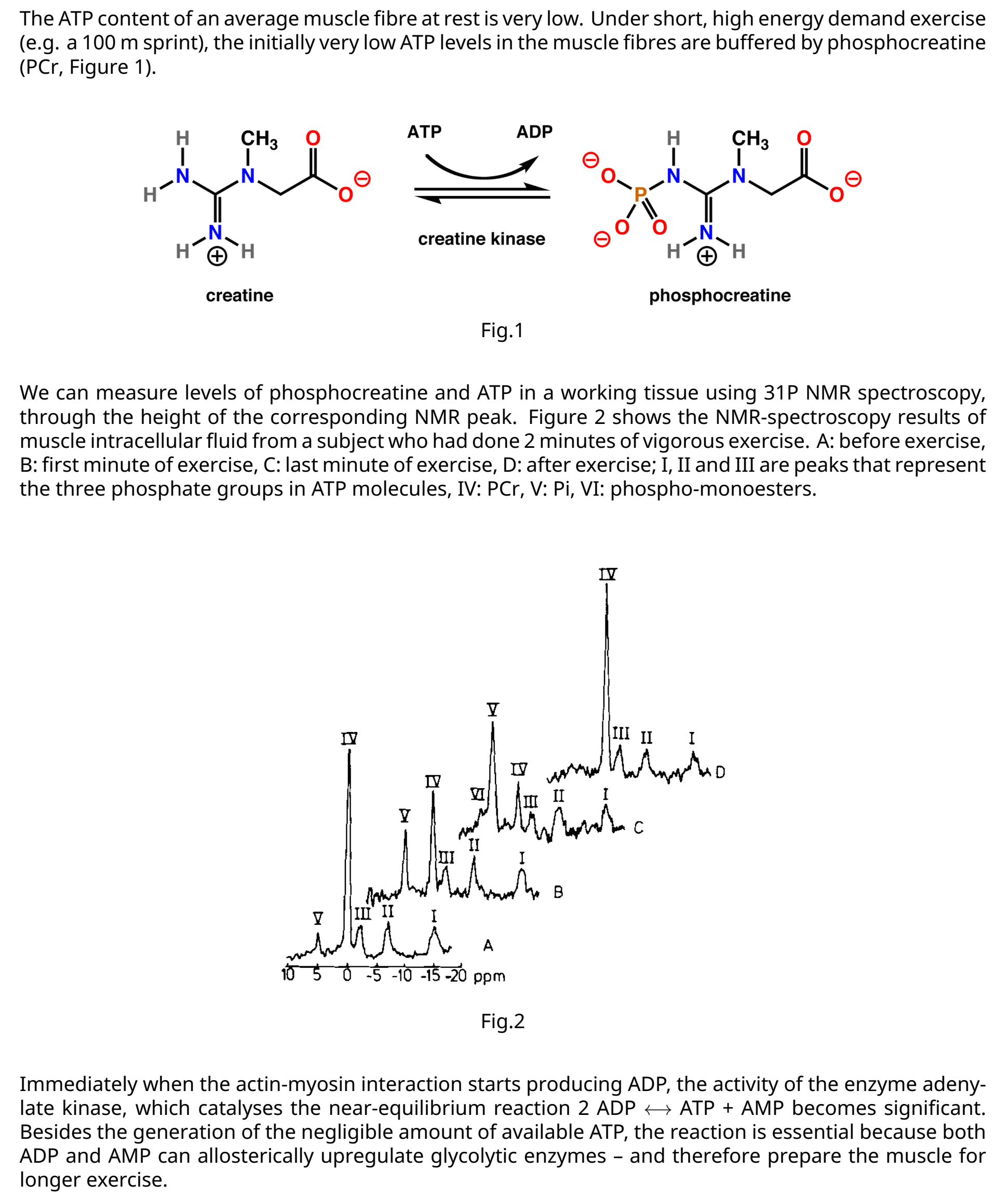The ATP content of an average muscle fibre at rest is very low. Under short, high energy demand exercise (e.g. a 100 m sprint), the initially very low ATP levels in the muscle fibres are buffered by phosphocreatine (PCr, Figure 1). ATP ADP Н CHз Н CHз .N. N. 'N' 'N' .N. creatine kinase H' Н H. creatine phosphocreatine Fig.1 We can measure levels of phosphocreatine and ATP in a working tissue using 31P NMR spectroscopy, through the height of the corresponding NMR peak. Figure 2 shows the NMR-spectroscopy results of muscle intracellular fluid from a subject who had done 2 minutes of vigorous exercise. A: before exercise, B: first minute of exercise, C: last minute of exercise, D: after exercise; I, II and III are peaks that represent the three phosphate groups in ATP molecules, IV: PCr, V: Pi, VI: phospho-monoesters. IV III II II III' II o $ -10 -15 -20 ppm Fig.2 Immediately when the actin-myosin interaction starts producing ADP, the activity of the enzyme adeny- late kinase, which catalyses the near-equilibrium reaction 2 ADP + ATP + AMP becomes significant. Besides the generation of the negligible amount of available ATP, the reaction is essential because both ADP and AMP can allosterically upregulate glycolytic enzymes - and therefore prepare the muscle for longer exercise. I.
The ATP content of an average muscle fibre at rest is very low. Under short, high energy demand exercise (e.g. a 100 m sprint), the initially very low ATP levels in the muscle fibres are buffered by phosphocreatine (PCr, Figure 1). ATP ADP Н CHз Н CHз .N. N. 'N' 'N' .N. creatine kinase H' Н H. creatine phosphocreatine Fig.1 We can measure levels of phosphocreatine and ATP in a working tissue using 31P NMR spectroscopy, through the height of the corresponding NMR peak. Figure 2 shows the NMR-spectroscopy results of muscle intracellular fluid from a subject who had done 2 minutes of vigorous exercise. A: before exercise, B: first minute of exercise, C: last minute of exercise, D: after exercise; I, II and III are peaks that represent the three phosphate groups in ATP molecules, IV: PCr, V: Pi, VI: phospho-monoesters. IV III II II III' II o $ -10 -15 -20 ppm Fig.2 Immediately when the actin-myosin interaction starts producing ADP, the activity of the enzyme adeny- late kinase, which catalyses the near-equilibrium reaction 2 ADP + ATP + AMP becomes significant. Besides the generation of the negligible amount of available ATP, the reaction is essential because both ADP and AMP can allosterically upregulate glycolytic enzymes - and therefore prepare the muscle for longer exercise. I.
Human Physiology: From Cells to Systems (MindTap Course List)
9th Edition
ISBN:9781285866932
Author:Lauralee Sherwood
Publisher:Lauralee Sherwood
Chapter8: Muscle Physiology
Section: Chapter Questions
Problem 12RE
Related questions
Question
(cell biology/human physiology)
1) Is it true that AMP and ADP levels are similarlyly indicators of energy status (as shown by ATP concentration)
2) Explain the change of peaks from I to V in the sequence of events from A to D?

Transcribed Image Text:The ATP content of an average muscle fibre at rest is very low. Under short, high energy demand exercise
(e.g. a 100 m sprint), the initially very low ATP levels in the muscle fibres are buffered by phosphocreatine
(PCr, Figure 1).
ATP
ADP
Н
CHз
Н
CHз
.N.
N.
'N'
'N'
.N.
creatine kinase
H'
Н
H.
creatine
phosphocreatine
Fig.1
We can measure levels of phosphocreatine and ATP in a working tissue using 31P NMR spectroscopy,
through the height of the corresponding NMR peak. Figure 2 shows the NMR-spectroscopy results of
muscle intracellular fluid from a subject who had done 2 minutes of vigorous exercise. A: before exercise,
B: first minute of exercise, C: last minute of exercise, D: after exercise; I, II and III are peaks that represent
the three phosphate groups in ATP molecules, IV: PCr, V: Pi, VI: phospho-monoesters.
IV
III II
II
III' II
o $ -10 -15 -20
ppm
Fig.2
Immediately when the actin-myosin interaction starts producing ADP, the activity of the enzyme adeny-
late kinase, which catalyses the near-equilibrium reaction 2 ADP + ATP + AMP becomes significant.
Besides the generation of the negligible amount of available ATP, the reaction is essential because both
ADP and AMP can allosterically upregulate glycolytic enzymes - and therefore prepare the muscle for
longer exercise.
I.
Expert Solution
This question has been solved!
Explore an expertly crafted, step-by-step solution for a thorough understanding of key concepts.
Step by step
Solved in 3 steps

Knowledge Booster
Learn more about
Need a deep-dive on the concept behind this application? Look no further. Learn more about this topic, biology and related others by exploring similar questions and additional content below.Recommended textbooks for you

Human Physiology: From Cells to Systems (MindTap …
Biology
ISBN:
9781285866932
Author:
Lauralee Sherwood
Publisher:
Cengage Learning

Biology: The Dynamic Science (MindTap Course List)
Biology
ISBN:
9781305389892
Author:
Peter J. Russell, Paul E. Hertz, Beverly McMillan
Publisher:
Cengage Learning

Human Biology (MindTap Course List)
Biology
ISBN:
9781305112100
Author:
Cecie Starr, Beverly McMillan
Publisher:
Cengage Learning

Human Physiology: From Cells to Systems (MindTap …
Biology
ISBN:
9781285866932
Author:
Lauralee Sherwood
Publisher:
Cengage Learning

Biology: The Dynamic Science (MindTap Course List)
Biology
ISBN:
9781305389892
Author:
Peter J. Russell, Paul E. Hertz, Beverly McMillan
Publisher:
Cengage Learning

Human Biology (MindTap Course List)
Biology
ISBN:
9781305112100
Author:
Cecie Starr, Beverly McMillan
Publisher:
Cengage Learning

Anatomy & Physiology
Biology
ISBN:
9781938168130
Author:
Kelly A. Young, James A. Wise, Peter DeSaix, Dean H. Kruse, Brandon Poe, Eddie Johnson, Jody E. Johnson, Oksana Korol, J. Gordon Betts, Mark Womble
Publisher:
OpenStax College

Biology 2e
Biology
ISBN:
9781947172517
Author:
Matthew Douglas, Jung Choi, Mary Ann Clark
Publisher:
OpenStax
